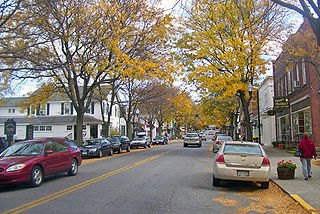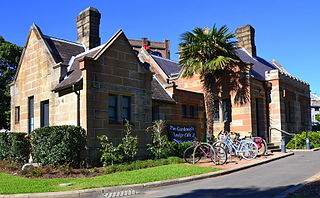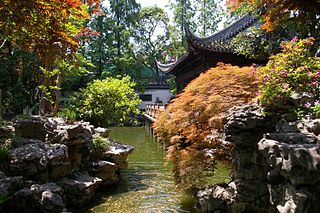
Millbrook is a village in Dutchess County, New York, United States. Millbrook is located in the Hudson Valley, on the east side of the Hudson River, 90 miles (140 km) north of New York City. Millbrook is near the center of the town of Washington, of which it is a part. As of the 2020 census, Millbrook's population was 1,455. It is often referred to as a low-key version of the Hamptons, and is one of the most affluent villages in New York.

Wang Wei (699–759) was a Chinese musician, painter, poet, and politician of the middle Tang dynasty. He is regarded as one of the most famous men of arts and letters of his era. Many of his poems survive and 29 of them are included in the 18th-century anthology Three Hundred Tang Poems. Many of his best poems were inspired by the local landscape.

A rock garden, also known as a rockery and formerly as a rockwork, is a garden, or more often a part of a garden, with a landscaping framework of rocks, stones, and gravel, with planting appropriate to this setting. Usually these are small Alpine plants that need relatively little soil or water. Western rock gardens are often divided into alpine gardens, scree gardens on looser, smaller stones, and other rock gardens.

Japanese gardens are traditional gardens whose designs are accompanied by Japanese aesthetics and philosophical ideas, avoid artificial ornamentation, and highlight the natural landscape. Plants and worn, aged materials are generally used by Japanese garden designers to suggest a natural landscape, and to express the fragility of existence as well as time's unstoppable advance. Ancient Japanese art inspired past garden designers. Water is an important feature of many gardens, as are rocks and often gravel. Despite there being many attractive Japanese flowering plants, herbaceous flowers generally play much less of a role in Japanese gardens than in the West, though seasonally flowering shrubs and trees are important, all the more dramatic because of the contrast with the usual predominant green. Evergreen plants are "the bones of the garden" in Japan. Though a natural-seeming appearance is the aim, Japanese gardeners often shape their plants, including trees, with great rigour.

Villa Borghese is a landscape garden in Rome, containing a number of buildings, museums and attractions. It is the third-largest public park in Rome, after the ones of the Villa Doria Pamphili and Villa Ada. The gardens were developed for the Villa Borghese Pinciana, built by the architect Flaminio Ponzio, developing sketches by Scipione Borghese, who used it as a villa suburbana, or party villa, at the edge of Rome, and to house his art collection. The gardens as they are now were remade in the late 19th century.

Garden design is the art and process of designing and creating plans for layout and planting of gardens and landscapes. Garden design may be done by the garden owner themselves, or by professionals of varying levels of experience and expertise. Most professional garden designers have some training in horticulture and the principles of design. Some are also landscape architects, a more formal level of training that usually requires an advanced degree and often a state license. Amateur gardeners may also attain a high level of experience from extensive hours working in their own gardens, through casual study, serious study in Master gardener programs, or by joining gardening clubs.

Victoria Park is a 9-hectare (22-acre) urban park situated on the corner of Parramatta Road and City Road, Camperdown, in the City of Sydney, New South Wales, Australia. The park is located adjacent to The University of Sydney and the Broadway Shopping Centre.

The Harvard Graduate School of Design (GSD) is the graduate school of design at Harvard University, a private research university in Cambridge, Massachusetts. It offers master's and doctoral programs in architecture, landscape architecture, urban planning, urban design, real estate, design engineering, and design studies.

The Chinese garden is a landscape garden style which has evolved over three thousand years. It includes both the vast gardens of the Chinese emperors and members of the imperial family, built for pleasure and to impress, and the more intimate gardens created by scholars, poets, former government officials, soldiers and merchants, made for reflection and escape from the outside world. They create an idealized miniature landscape, which is meant to express the harmony that should exist between man and nature.

The English landscape garden, also called English landscape park or simply the English garden, is a style of "landscape" garden which emerged in England in the early 18th century, and spread across Europe, replacing the more formal, symmetrical French formal garden which had emerged in the 17th century as the principal gardening style of Europe. The English garden presented an idealized view of nature. Created and pioneered by William Kent and others, the “informal” garden style originated as a revolt against the architectural garden and drew inspiration from paintings of landscapes by Salvator Rosa, Claude Lorrain, and Nicolas Poussin.

The University of Alberta Botanic Garden is Alberta's largest botanical garden. It was established in 1959 by the University of Alberta. It is located approximately 3.1 km (1.9 mi) west of the city of Edmonton, Alberta and 5.9 km (3.7 mi) north of the town of Devon, in Parkland County.

The Chinese Garden of Friendship is a heritage-listed 1.03-hectare (3-acre) Chinese garden at 1 Harbour Street, in the Sydney Central Business District, City of Sydney, New South Wales, Australia. Modelled after the classic private gardens of the Ming dynasty, the garden offers an insight into Chinese heritage and culture. It was designed by Guangzhou Garden Planning & Building Design Institute, Tsang & Lee, and Edmond Bull & Corkery. It was built between 1986-1988 by Gutteridge Haskins & Davey, the Darling Harbour Authority, Imperial Gardens, Leightons, and Australian Native Landscapes. The gardens were added to the New South Wales State Heritage Register on 5 October 2018.
Saco Rienk DeBoer was a Dutch landscape architect and city planner. He was born on September 7, 1883, in Ureterp, Opsterland, Friesland, Netherlands to architect Rienk Kornelius De Boer and avid gardener Antje Dictus Benedictus. He studied engineering and passed the Junior Engineer (surveyor) exam. He went on to study landscape architecture at The Royal Imperial School of Horticulture in Germany. He was diagnosed with tuberculosis, on the advice of doctors him to return home to Ureterp where he opened an office. His symptoms worsened in the summer of 1908, on doctor and family advice he emigrated to the United States in October 1908 be cured at the Dutch operated Bethesda Sanatarium in Maxwell, NM. In 1909 when Bethesda Sanitarium moved to Denver, he moved with it, planning the landscaping for the new building. He became the official Landscape Architect of Denver from 1910 to 1931. He also designed the planned community of Boulder City, Nevada. In 1919, he joined with another Dutchman, M. Walter Pesman, to form a partnership. Together their projects were many, among them the landscaping of both sides of Speer Boulevard in Denver, and two early and innovative Colorado subdivisions, Bonnie Brae in Denver and The Glens in Lakewood, both of which feature winding streets and multiple small "pocket parks."

The Gulbenkian Park also known as Gulbenkian Garden is located in Lisbon, Portugal. It was created in 1969 and is part of the cultural center where the headquarters of the Calouste Gulbenkian Foundation, Gulbenkian Museum and the José de Azeredo Perdigão Modern Art Centre are situated enriching the cultural importance of the garden.

Paris today has more than 421 municipal parks and gardens, covering more than three thousand hectares and containing more than 250,000 trees. Two of Paris's oldest and most famous gardens are the Tuileries Garden, created in 1564 for the Tuileries Palace, and redone by André Le Nôtre in 1664; and the Luxembourg Garden, belonging to a château built for Marie de' Medici in 1612, which today houses the French Senate. The Jardin des Plantes was the first botanical garden in Paris, created in 1626 by Louis XIII's doctor Guy de La Brosse for the cultivation of medicinal plants. Between 1853 and 1870, the Emperor Napoleon III and the city's first director of parks and gardens, Jean-Charles Adolphe Alphand, created the Bois de Boulogne, the Bois de Vincennes, Parc Montsouris and the Parc des Buttes Chaumont, located at the four points of the compass around the city, as well as many smaller parks, squares and gardens in the neighborhoods of the city. One hundred sixty-six new parks have been created since 1977, most notably the Parc de la Villette (1987–1991) and Parc André Citroën (1992).
Julia Lester Dillon (1871–1959) was an American teacher from Georgia, who because of the death of her husband and her hearing loss, trained in landscape architecture. She was one of the first women to write extensively about gardening in the south and ran a regularly featured column which appeared in several newspapers and magazines. She designed spaces to enhance post offices for the U.S. Department of the Treasury and created the Memorial Park in Sumter, South Carolina. Based on her experience, she then served as Sumter Superintendent of Parks and Trees for twenty years. Dillon remained in Sumter after retiring. She continued writing until 1954, despite losing both her hearing and her sight. Julia Lester Dillon died in Sumter on March 24, 1959. She is buried in Magnolia Cemetery in Augusta, Georgia. She was inscribed upon the Georgia Women of Achievement roster in 2003.
Lester Albertson Collins (1914–1993) was an American landscape architect. He studied landscape architecture at Harvard, including studies of gardens in East Asia in 1940. After World War II, he began to teach as a professor at Harvard. Collins traveled to Japan in 1953 to work for a year on the translation of an ancient Japanese book. In 1954 he settled in Washington, D.C., and worked for the firm Simonds & Simonds in Pittsburgh. He worked on town plans, campus plans, and public gardens such as the Hirshhorn Sculpture Garden. Over 55 years, he developed and directed the Innisfree Garden in Millbrook, New York.






















